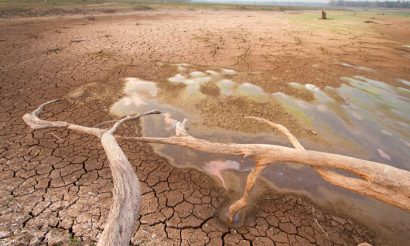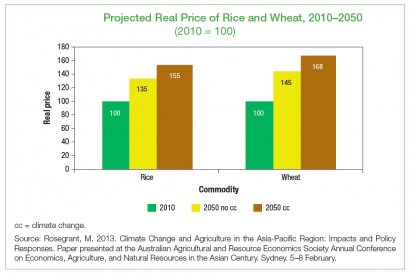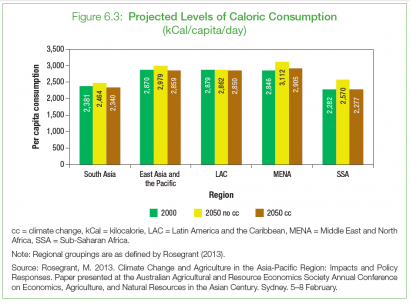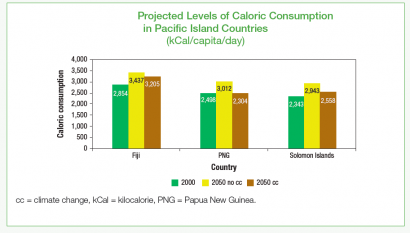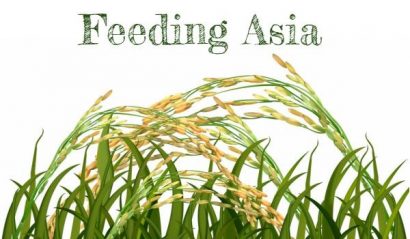Feeding Asia: Climate change and the devastation of food security
- Like
- Digg
- Del
- Tumblr
- VKontakte
- Buffer
- Love This
- Odnoklassniki
- Meneame
- Blogger
- Amazon
- Yahoo Mail
- Gmail
- AOL
- Newsvine
- HackerNews
- Evernote
- MySpace
- Mail.ru
- Viadeo
- Line
- Comments
- Yummly
- SMS
- Viber
- Telegram
- Subscribe
- Skype
- Facebook Messenger
- Kakao
- LiveJournal
- Yammer
- Edgar
- Fintel
- Mix
- Instapaper
- Copy Link
Posted: 16 February 2017 | Roy Manuell | Digital Editor | No comments yet
New Food considers the potentially exponential impact climate change could have on both global and Asian food security…
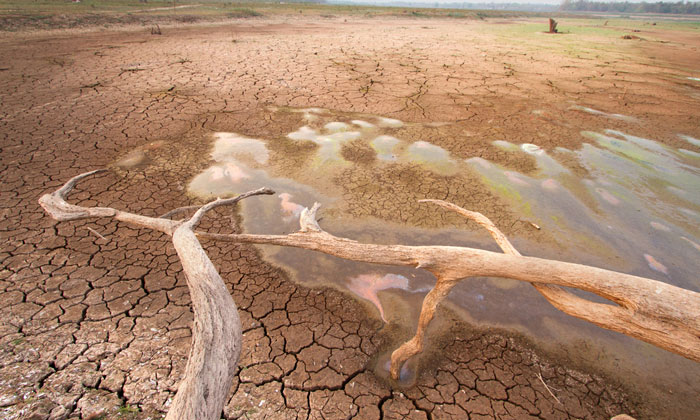

In New Food‘s ‘Feeding Asia’ series we have looked at the impact of population growth on food security as well as maximising cold chain efficiency in India.
In our latest instalment, we consider the potentially exponential impact climate change could have on both global and Asian food security.
“With more than 60% of the population relying on agriculture and food production as a source of income, the Asia and Pacific region is particularly sensitive to the potential damage caused by climate change.”
So what is actually happening?
Evidence of climate change is seen in rising carbon dioxide (CO2) concentrations, rising global mean temperatures, changing precipitation patterns, and rising sea levels:
- Rising CO2 Concentrations: CO2 emissions have long been on the rise, particularly since the 1950s. From an annual rate of less than 26 billion ton/year in 1990, they are projected to rise to 41 billion ton/year by 2020 (World Bank 2012). Total GHG emissions would reach 56 billion tons of CO2 equivalent (GtCO2e) in a “business as usual” scenario. If current pledges to reduce emissions are fully implemented, projected emissions in 2020 would range from 53 to 55 GtCO2e—still too high.
- Rising Global Mean Temperature: Scientific research shows that humans are the “unequivocal” cause of rising global mean temperatures and climate system warming (World Bank 2012). Thus far, global mean temperatures have increased by roughly 0.8°C compared with preindustrial levels. Recent research shows that increases since the mid-20th century were caused by increased GHG concentrations stemming from anthropogenic activities. One study, for instance, illustrated just how human activity influences short-term temperature variations by removing nonhuman factors such as solar variability, volcanic aerosol effects, and the El Niño–Southern oscillation events.
- Change in Precipitation Patterns: Current climate models project that precipitation in tropical precipitation maxima (such as monsoons) and high latitude regions will rise, especially over the tropical Pacific. However, precipitation will decrease in subtropical regions as a consequence of a generally intensifying global hydrological cycle. Global mean water vapour and evaporation are also expected to increase. In the absence of additional aerosol particle effects (from volcanic eruptions, for example), GHG emissions are expected to heighten the water cycle, making dry areas drier and wet areas wetter. Based on results from the latest 13 climate models of the World Climate Research Programme’s Coupled Model Intercomparison Project Phase 5, total precipitation on wet days is projected to increase by about 10%. Extreme precipitation events are also expected to increase by 20% under the representative concentration pathway 8.5 (4+°C) emission scenario.This adds the substantial additional risk of flooding.
- Sea-Level Rise: With more accurate methods of monitoring the rise in sea levels— such as tidal gauges and satellite observations—the IPCC has confirmed that sea levels have risen more than 20 centimetres (cm) from preindustrial times to 2009 (Church and White 2011). The average rate during the 20th century was 1.7 millimetres per year (mm/year) (or 1.7 centimetres per decade [cm/decade]), accelerating 3.2 mm/year (3.2 cm/decade) since the 1990s. There remain uncertainties as to the share of contributing factors, as the sum of individually measured components is less than the total observed sea-level rise (IPCC 2007a). The rate of observed sea-level increases varies by region, due to causes such as each ocean’s distinctive heating, ocean dynamics such as winds and currents, sources and geographical location of changes to the cryosphere (snow cover and solid precipitation, sea ice, lake and river ice, glaciers, ice caps, ice sheets, permafrost and seasonally frozen ground), and subsidence or uplifting of continental margins.
If you recourse to our previous definition of food security as largely:
- Availability of food
- Accessibility of food
- Utilisation of food
We can now begin to analyse how precisely climate change will impact upon food security.
Firstly the notion of unpredictability will significantly affect food production in the region. Changes in agro-ecological conditions will have economic and sociological impacts, forcing many to relocate and find alternative employment due to deteriorating crop yields. As a result, consumption habits of these people will too alter.
Significant changes in weather patterns of which we are already seeing in countries such as Indonesia, South East Asia’s largest economy and Bangladesh, is severely threatening food security.
Semi-arid and sub-humid regions will see the largest effect, reducing crop yields, livestock, and productivity levels. Many of these areas are found South Asia which has one of the highest levels of chronic undernourishment and will thus be exposed to the highest degree of instability.
Different regions in different ways
The effects of climate change differ highly according to the placement of the nation within Asia.
It goes without saying that the continent is vast and regional diversity is significant.
In South Asia, for example, as reported by the Asian Development Bank, climate change will likely bring a substantial reduction in aggregate crop production.
The effect will be larger on wheat than on rice yields; on average it is expected that rice yields will significantly decline. Upstream glacial runoff will increase, but mostly during monsoons rather than during the dry season, when water is needed most.
“It is expected that rice yields will significantly decline…”
The flood risk will further increase.
Rice and wheat prices
This will have a widespread effect on the global cereal and indeed overall food industry from an economic perspective. It is expected that the prices of cereals and soybeans are projected to rise as much as by 70% by 2050. Rice and wheat prices will shoot up as you can see by the graph below.
Even without climate change the prices of these staples will rise by 35% for rice and 45% for wheat.
The main reason for this?
An increased pressure on agricultural resources stemming from non-agricultural demand for land and labour, as discussed in our previous focus on demographic shifts. Climate change will add a stress we cannot ignore and an additional 20% increase in the price of rice and 23% for wheat.
This will affect the entire world, both consumers and manufactures and processor and regulators and… Well, the list could fill an afternoon.
Malnutrition
These price rises will only exacerbate malnutrition polemic in Asia, and childhood malnutrition which is directly linked to caloric intake will be particularly affected.
To read the original report from the Asian Development Bank, click here.
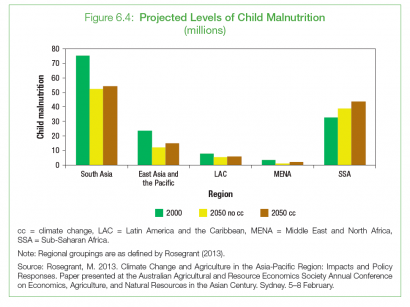

Pacific Islands
It is thought that malnutrition will be specifically evident in the Pacific Islands. The islands, unequivocally areas of outstanding natural beauty and with themselves very small carbon footprints, present a very sad potential example of who will be the first and very real victims of climate change.
The light at the end of the tunnel
As proposed by the Asian Development Bank, some solutions might be the introduction of:
A policy package including:
- An increase in research and extension spending (reaching 2% of agricultural GDP).
- The optimisation of crop varieties to climate change.
- Increasing the use of nitrogenous fertilisers from 30 to 50 kilograms per hectare (kg/ha).
- Applying public incentives to increase fish and livestock production.
Adaptation
Responsible and pre-planned adaptation strategies will be key to mitigating the effects of climate change on food security in the Asia-Pacific region.
Several measures are possible such as:
- Better land and water resource management;
- Improved risk assessment and management of floods and droughts
- Provide benefits from reduced greenhouse gas emissions
- Improved governance and better regional cooperation.
Conclusion
In order to implement these measures, a full embrace of new technologies will be important in order to reclaim degraded agricultural and arable land. A community-driven response will be further key to ensuring that soil and water resources are effectively managed.
Doing nothing is not an option and while speculation has and is driving the conversation on climate change and food security, adaptation and mitigation strategy must start now.
We cannot emphasise this point enough. In order to correctly provide enough food and water for the world, we must, act, now.
Look out for the next instalment of New Food’s ‘Feeding Asia’ series that will consider Oceania as a potential food bowl for Asia.
With many thanks to the Asian Development Bank and The Economist Intelligence Unit.
- An introduction to the increasing issue of food security in Asia
- The problem with Asia’s population growth for food security
- How improving cold chain efficiency could alleviate India’s malnutrition




